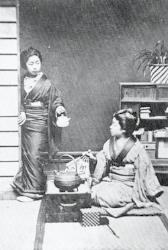Japanese Village, Knightsbridge on:
[Wikipedia]
[Google]
[Amazon]


 The Japanese Village in
The Japanese Village in
'Knightsbridge Green Area: Scotch Corner and the High Road', Survey of London: volume 45: Knightsbridge (2000), pp. 79-88 The exhibition was built to resemble a traditional Japanese village, completely contained within Humphreys' Hall (which was south of Knightsbridge and east of what is now Trevor Street). It employed around 100 Japanese men and women, and included segregated sleeping accommodation. According to advertisements placed in the ''"Knightsbridge Green Area: Scotch Corner and the High Road: The Japanese Native Village"
in ''Survey of London'': Volume 45, Knightsbridge, ed. John Greenacombe (London, 2000), pp. 79-88, via British History Online, accessed 10 October 2020
The exhibition continued for another eighteen months. By February 1887, over a million people had visited it. It closed in June 1887.
Cultural Appropriation or Swiftian Satire? Gilbert and Sullivan’s ''The Mikado''
{{coord, 51.5015, -0.1639, type:landmark_region:GB, display=title Exhibitions in the United Kingdom 1880s in London Victorian culture Japanese culture Events in London


 The Japanese Village in
The Japanese Village in Knightsbridge
Knightsbridge is a residential and retail district in central London, south of Hyde Park. It is identified in the London Plan as one of two international retail centres in London, alongside the West End.
Toponymy
Knightsbridge is an ancien ...
, London, was a late Victorian era
In the history of the United Kingdom and the British Empire, the Victorian era was the period of Queen Victoria's reign, from 20 June 1837 until her death on 22 January 1901. The era followed the Georgian period and preceded the Edwardia ...
exhibition of Japanese culture located in Humphreys' Hall, which took place from January 1885 until June 1887. The exhibition employed around 100 Japanese men and women in a setting built to resemble a traditional Japanese village.
Description
The exhibition was a commercial venture organised by Tannaker Buhicrosan (1839–1894), who had been organising travelling Japanese exhibitions in Britain for several years beforehand. As a result of the opening up of Japan to trade with Britain in the 1850s, an English craze for all things Japanese had built through the 1860s and 1870s, fed by the British perception of Japan as a mediaeval culture. This resonated particularly with devotees of the Aesthetic movement of the late nineteenth century and made the exhibition very popular,Jones, pp. 688–93 with over 250,000 visitors during its early months.British history online'Knightsbridge Green Area: Scotch Corner and the High Road', Survey of London: volume 45: Knightsbridge (2000), pp. 79-88 The exhibition was built to resemble a traditional Japanese village, completely contained within Humphreys' Hall (which was south of Knightsbridge and east of what is now Trevor Street). It employed around 100 Japanese men and women, and included segregated sleeping accommodation. According to advertisements placed in the ''
Illustrated London News
''The Illustrated London News'' appeared first on Saturday 14 May 1842, as the world's first illustrated weekly news magazine. Founded by Herbert Ingram, it appeared weekly until 1971, then less frequently thereafter, and ceased publication i ...
'', "Skilled Japanese artisans and workers (male and female) will illustrate the manners, customs, and art-industries of their country, attired in their national and picturesque costumes. Magnificently decorated and illuminated Buddhist temple. Five o’clock tea in the Japanese tea-house. Japanese Musical and other Entertainments. Every-day Life as in Japan".While Gilbert and Sullivan were writing their opera ''
The Mikado
''The Mikado; or, The Town of Titipu'' is a comic opera in two acts, with music by Arthur Sullivan and libretto by W. S. Gilbert, their ninth of fourteen Gilbert and Sullivan, operatic collaborations. It opened on 14 March 1885, in London, whe ...
'' (1885), W. S. Gilbert
Sir William Schwenck Gilbert (18 November 1836 – 29 May 1911) was an English dramatist, librettist, poet and illustrator best known for his collaboration with composer Arthur Sullivan, which produced fourteen comic operas. The most fam ...
visited the exhibition and engaged Japanese people from the village to teach his cast aspects of Japanese behaviour. In May 1885, the hall burnt down overnight and one of the Japanese employees was killed in the blaze. However Mr Buhicrosan immediately announced that the hall and the exhibit would be rebuilt as quickly as possible. As it happened the exhibit employees were already committed to visit Berlin and appear at the 1885 International Hygiene Exhibition in Berlin. They proceeded to fulfill the engagement. Meanwhile, the hall and the village exhibit were both reconstructed and the exhibition re-opened to the public in December 1885 with "several streets of shops ... two temples and various free-standing idols, and a pool spanned by a rustic bridge".in ''Survey of London'': Volume 45, Knightsbridge, ed. John Greenacombe (London, 2000), pp. 79-88, via British History Online, accessed 10 October 2020
Notes
References
* * * *External links
Cultural Appropriation or Swiftian Satire? Gilbert and Sullivan’s ''The Mikado''
{{coord, 51.5015, -0.1639, type:landmark_region:GB, display=title Exhibitions in the United Kingdom 1880s in London Victorian culture Japanese culture Events in London